Your heart is an amazing organ—about the size of your fist—but it works tirelessly, day and night, to keep you alive. Most of us know the heart pumps blood, but how does it really work? Let’s break it down into a simple, easy-to-follow explanation.
What Is the Heart?
The heart is a muscular organ located slightly to the left of the center of your chest. It works like a pump, sending blood throughout your body to deliver oxygen and nutrients and carry away waste products like carbon dioxide.
Think of your heart as your body’s engine. Without it, nothing else can function.
The Four Chambers of the Heart
The heart is divided into four chambers:
-
Right atrium (upper right)
-
Right ventricle (lower right)
-
Left atrium (upper left)
-
Left ventricle (lower left)
Blood flows through these chambers in a specific order, like a well-organized traffic system. Here’s how it works:
-
Blood without oxygen returns from the body to the right atrium.
-
It moves into the right ventricle, which pumps it to the lungs.
-
In the lungs, blood picks up oxygen and releases carbon dioxide.
-
The oxygen-rich blood comes back to the left atrium.
-
It flows into the left ventricle, which pumps it out to the rest of the body.
This whole cycle repeats every single time your heart beats.
Heart Valves: One-Way Doors
Inside the heart are valves that work like one-way doors. They make sure blood flows in the right direction and doesn’t go backward. There are four main valves:
-
Tricuspid valve
-
Pulmonary valve
-
Mitral valve
-
Aortic valve
Each valve opens and closes with every beat, keeping the blood moving smoothly through the heart and body.
The Heartbeat: What Makes It Happen?
Your heart beats thanks to a special electrical system that tells it when to contract (squeeze) and relax. The heartbeat has two main parts:
-
Systole: When the heart contracts and pumps blood out.
-
Diastole: When the heart relaxes and fills with blood again.
This rhythm—lub-dub, lub-dub—is what you hear as your heartbeat.
The natural “pacemaker” of the heart is a group of cells called the sinoatrial (SA) node, located in the right atrium. It sends out electrical signals to start each heartbeat, like a tiny spark plug.
How Blood Travels: The Circulatory System
The heart is part of a larger system called the circulatory system. This system includes:
-
Arteries – Carry oxygen-rich blood away from the heart.
-
Veins – Bring oxygen-poor blood back to the heart.
-
Capillaries – Tiny blood vessels where the exchange of oxygen and nutrients happens.
Blood travels in two main loops:
-
Pulmonary circulation – Heart to lungs and back.
-
Systemic circulation – Heart to the rest of the body and back.
Together, these systems ensure that every cell in your body gets the oxygen and nutrients it needs.
How Fast Does the Heart Work?
On average, your heart beats:
-
About 60–100 times per minute at rest.
-
Over 100,000 times per day.
-
That’s more than 35 million times a year!
And it pumps about 5 liters (1.3 gallons) of blood every minute, circulating your entire blood supply once every minute or so.
Why Is Heart Health Important?
Since your heart never stops working, it needs to stay strong and healthy. A poor diet, lack of exercise, smoking, and stress can damage your heart over time.
Taking care of your heart can:
-
Help you live longer
-
Improve energy levels
-
Lower your risk of heart disease, stroke, and other problems
Simple Tips for a Healthy Heart
-
Eat heart-friendly foods: fruits, vegetables, whole grains, lean proteins.
-
Stay active: Aim for 30 minutes of exercise most days.
-
Avoid smoking and limit alcohol.
-
Get enough sleep.
-
Manage stress through relaxation, hobbies, or mindfulness.
-
See your doctor for regular checkups.
Final Thoughts
Your heart is one of the most important organs in your body. Even though it works automatically, taking the time to understand how it functions—and how to care for it—can make a big difference in your health and quality of life.
So next time you feel your heart beating, remember: it’s doing an incredible job, every second of every day, just for you.
